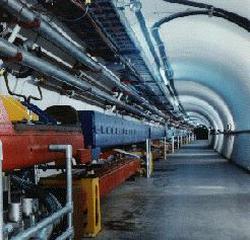In Search of Hidden Dimensions

Most of us feel comfortable with life in four dimensions–the three dimensions of space and one of time. However, some physicists think that at least six more dimensions exist, compacted into tiny sizes. This weird 10-dimensional universe is part of string theory, a sweeping but unproven framework that ties together nature’s basic forces. In the 15 March PRL, theorists offer a detailed blueprint of how to search for these extra dimensions in particle accelerators. Surprisingly, this shadow world may be far more accessible than physicists thought. Indeed, some of the new dimensions may inhabit spaces as large as a millimeter across.
Physicists believe that in the cauldron of the big bang the four fundamental forces–strong and weak forces in atomic nuclei, electromagnetism, and gravity–acted as one. In the simplest extrapolation from current knowledge, this unification occurs only at extremely high energies and at the smallest possible spatial scale, just m. String theory, the most popular unification theory, dictates that particles such as quarks and electrons are tiny loops that vibrate in 10-dimensional space. Six of those dimensions might have curled up at the smallest scale after the big bang, while the others grew into the cosmos we see today. “We are in some sense trapped on a wall in a higher-dimensional universe. We can’t turn our heads in the direction that those extra dimensions lie in,” explains Joseph Lykken of the Fermi National Accelerator Laboratory (Fermilab) in Illinois.
In the past decade string theorists have suggested that at least some of the extra spatial dimensions can be probed indirectly at energies far lower than the big bang, and perhaps even at length scales as shockingly large as 1 mm. Now, several teams have calculated exactly how physicists could measure those dimensions in high-energy experiments. Eugene Mirabelli and his colleagues at the Stanford Linear Accelerator Center (SLAC) analyzed collisions in which gravitons–the postulated carriers of the gravitational force–radiate into the other dimensions. Their PRL paper describes the precise signature of such events: a single photon or particle jet zooming off in one direction, but no observed particles balancing the reaction on the other side. Current experiments at CERN’s LEP 2 accelerator in Switzerland are sensitive enough to probe for new dimensions to a size of 0.48 mm, the team concludes. Published results from the Tevatron collider at Fermilab rule out hidden dimensions about twice as big, but new data will allow physicists to probe on a finer scale.
Other teams have derived similar theoretical constraints, including Gian Giudice and coworkers at CERN. “The idea that the Universe has extra dimensions is very compelling,” says SLAC coauthor Michael Peskin. “The probability of a millimeter scale is very low, but it’s fantastically interesting, so it’s important to tell the experimenters exactly what to look for.”
Theorists praise the new papers as essential steps. “This is the detailed follow-up needed to put some meat on these ideas and see how we can test them experimentally,” says Thomas Banks of Rutgers University. Adds Lykken: “In the next year or two, either people will lose interest in this idea or it will enter a data-driven phase. This actually has the smell of something promising.”
–Robert Irion
Robert Irion is a freelance science writer based in Santa Cruz, CA.


